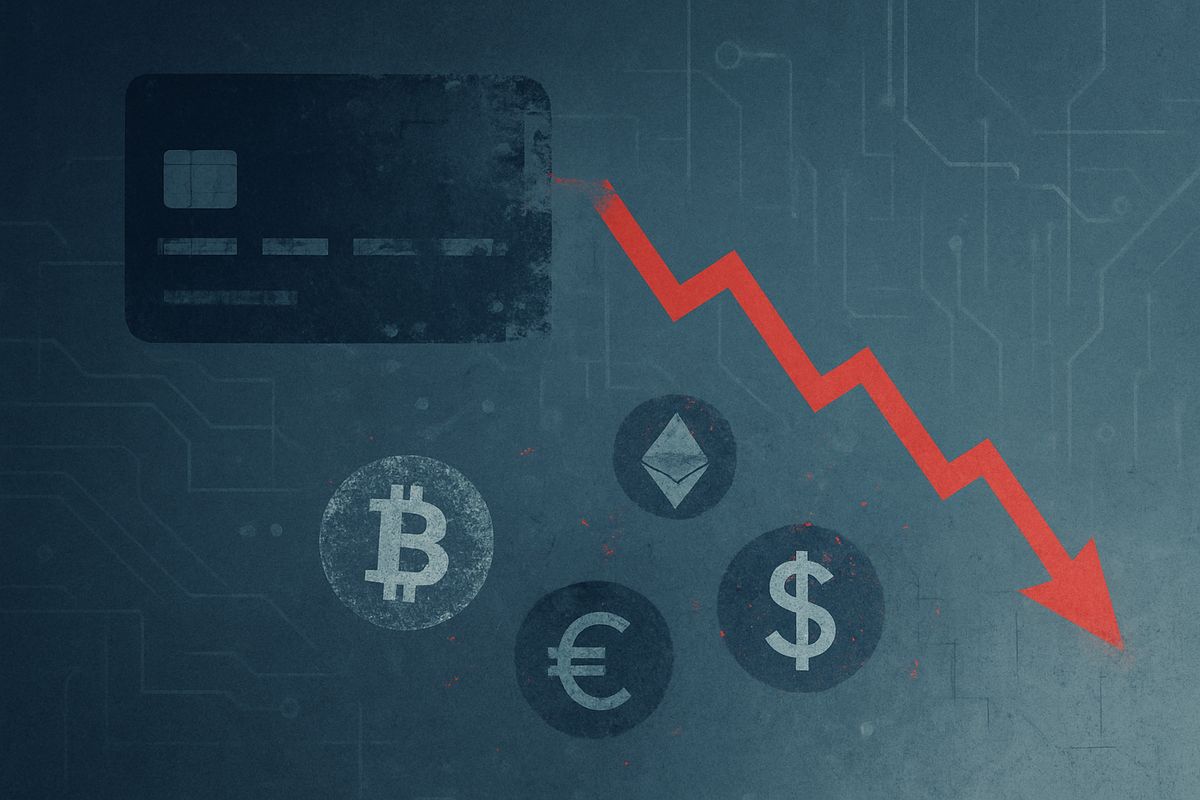
Newport Beach, CA – September 30, 2025 – BlueOne Card, Inc. (OTCQX: BCRD), a publicly traded financial technology company, has sent ripples of concern through the small-cap FinTech sector with its Q1 earnings report for the quarter ended June 30, 2025. The company disclosed an alarmingly low sales figure of just USD 0.095556 (approximately $95,556) for the period, accompanied by a net loss of USD 0.27403 million ($274,030). These figures, released recently, paint a stark picture of a company struggling to generate meaningful revenue and facing significant questions about its operational viability and long-term future.
The immediate implications of such negligible sales for a public entity with a market capitalization in the tens of millions are profound. It suggests a severe disconnect between market valuation and actual revenue generation, pointing to either a nascent stage of commercialization, a struggling business model, or an unsuccessful strategic pivot. For investors, these numbers underscore the inherent risks associated with small-cap FinTech investments, where promising ideas often face immense challenges in achieving sustainable commercial scale. The company's own management has previously raised "substantial doubt about its ability to continue as a going concern," a warning that now appears more prescient than ever.
Detailed Coverage: A Precarious Financial Trajectory
BlueOne Card, Inc.'s Q1 2025 earnings report (for the quarter ended June 30, 2025) highlights a critical juncture for the company. The reported sales of $95,556 are not only exceptionally low for a public company but also indicative of deep-seated issues in its ability to monetize its prepaid card and payment solutions. This minimal revenue, coupled with a net loss, signifies that the company's operational expenses far outstrip its income, leading to an unsustainable burn rate.
The company, founded in 2007 and headquartered in Newport Beach, California, has a history of strategic shifts and attempts to establish itself in the competitive FinTech landscape. Initially incorporated in Nevada, it became publicly listed on November 10, 2010. After several name changes, it rebranded to BlueOne Card, Inc. and adopted the ticker (OTCQX: BCRD) in June 2020, focusing on payout solutions and prepaid debit cards for unbanked workers. A notable development was its uplisting to the OTCQB in April 2022, aimed at increasing visibility. More recently, in October 2024, BlueOne Card announced and subsequently completed in December 2024, the acquisition of a 60% equity interest in Millennium EBS, Inc. for $12 million. This move was intended to transform BlueOne Card into a prominent payment hub provider. However, the Q1 2025 sales figures, post-acquisition, suggest that this strategic expansion has yet to translate into significant revenue growth.
Leading up to the Q1 2025 report, earlier financial filings for Q2 2025 (ending September 30, 2024) already detailed a net loss of $234,061 and zero revenue from prepaid debit card sales, accompanied by the "going concern" warning. The company's fiscal year 2025 (ending March 31, 2025) reported a trailing 12-month revenue of $110K and a net loss of $1.051 million. These consistent losses and insignificant revenues have taken a toll on market sentiment. While specific immediate reactions to the Q1 2025 report are still unfolding, the broader trend shows BlueOne Card's stock price underperforming, with a closing price of $5.06 on September 10, 2025, down 14.96% from the previous day, and a 10.75% decline over the past 365 days. Over the six months leading up to September 11, 2025, its share price underperformed the S&P 500 Index by a significant -31.86%. Analyst coverage remains scarce, further highlighting the company's precarious position.
Ripple Effects: Who Wins and Loses in a Struggling FinTech Landscape?
BlueOne Card, Inc.'s profound financial struggles, marked by its Q1 2025 sales, serve as a stark reminder of the intense competition and inherent risks within the FinTech industry. While the direct impact of such a small company's performance on the broader market might seem limited, its situation sends clear signals about the challenges facing small-cap FinTechs and subtly shifts dynamics among competitors.
Potential "Winners": Established market leaders in the prepaid card and payment processing space, such as Visa (NYSE: V), Mastercard (NYSE: MA), Green Dot Corporation (NYSE: GDOT), and PayPal (NASDAQ: PYPL), stand to benefit. These giants, with their robust infrastructure, extensive networks, and strong brand recognition, are better positioned to attract customers disillusioned by smaller, struggling providers. The global prepaid card market continues to grow, and any market share relinquished by a failing player like BlueOne Card would likely be absorbed by these dominant forces. Similarly, innovative tech-forward companies like Block, Inc. (NYSE: SQ) (formerly Square) and Apple (NASDAQ: AAPL), which are expanding their digital payment ecosystems, could also gain as consumers seek more reliable and integrated solutions.
Potential "Losers": The primary "losers" from BlueOne Card's struggles are likely other small-cap FinTechs, particularly those operating with similar business models or facing comparable financial vulnerabilities. BlueOne Card's difficulties could cast a shadow over the entire segment, leading to increased investor scrutiny, making it harder for other unproven or unprofitable startups to secure funding or attract customers. The event reinforces the narrative that only well-capitalized or highly differentiated FinTechs will survive, potentially leading to a "flight to quality" among investors. Furthermore, any high-profile FinTech failure, even one involving minimal customer funds, can broadly erode customer trust in digital financial services, potentially slowing adoption across the industry.
From an acquisition standpoint, BlueOne Card itself could become a target, not for its thriving operations, but for its distressed assets. Larger financial institutions or payment companies might consider acquiring its intellectual property, niche technology, or even its small customer base at a significantly discounted valuation. Such deals are often structured as asset purchases to avoid assuming the struggling company's liabilities, reflecting the ongoing consolidation trend in the FinTech sector driven by rising interest rates and valuation pressures.
Wider Significance: A Microcosm of FinTech's Maturation
BlueOne Card, Inc.'s ongoing financial distress, highlighted by its Q1 2025 earnings, is more than an isolated corporate event; it serves as a potent microcosm of the broader shifts and challenges currently reshaping the FinTech industry. The company's predicament underscores several critical trends: the undeniable push for profitability, the intense competition and consolidation impacting small-cap players, and the ever-present shadow of regulatory scrutiny.
This situation perfectly illustrates the industry's pivot from a "growth-at-all-costs" mentality, prevalent during the peak of venture capital funding, to a more demanding focus on sustainable economics and profitability. BlueOne Card's consistent losses and insignificant revenues run directly counter to the trend where a significant majority of FinTech firms are now reportedly achieving profitability. This highlights a failure to adapt to the new market imperative where investors prioritize a clear path to positive cash flow over speculative potential.
The struggles also exemplify the increasing challenges for small-cap players in a tightening funding environment. The decline in FinTech funding since 2021 has disproportionately impacted smaller, less established companies that rely heavily on external capital. BlueOne Card's accumulated deficit of over $5 million and a working capital deficit exceeding $1.9 million clearly demonstrate the precarious position of undercapitalized entities. This environment often forces consolidation, with larger, more stable players acquiring smaller, struggling firms. BlueOne Card's own acquisition of Millennium EBS, Inc. was an attempt to position itself for growth, yet the lack of revenue generation post-acquisition indicates that even strategic M&A doesn't guarantee success if underlying business model weaknesses persist.
Potential ripple effects on the broader FinTech ecosystem include an erosion of investor and customer confidence, particularly towards other small or unprofitable ventures. This could lead to increased scrutiny of business models and unit economics across the industry, reinforcing the need for robust revenue models and efficient operations. Regulatory bodies are also likely to increase their focus on the financial stability of FinTech companies, especially those involved in payment processing, to protect consumers. This could lead to stricter capital requirements or enhanced reporting obligations for payment providers, particularly those operating with low reserves.
Historically, BlueOne Card's struggles echo those of other FinTech failures. Examples like Wonga (payday lending, UK, 2018), which collapsed under regulatory fines, or early digital currency platforms like Beenz.com (2001), which struggled with market readiness, highlight the absolute necessity of ethical practices, robust financial controls, and strict regulatory compliance, alongside a clear value proposition and market adoption. The current scenario reminds us that innovation alone is not sufficient; a sustainable business model, robust capital, strong execution, and unwavering compliance are paramount for survival and success in the evolving FinTech ecosystem.
What Comes Next: A Crossroads for BlueOne Card
BlueOne Card, Inc. stands at a critical juncture, facing immediate threats to its existence and requiring drastic measures to secure any semblance of a long-term future. The path forward is fraught with challenges, and several scenarios could unfold.
In the short term, the company's survival hinges on aggressive cost reduction and urgent revenue generation initiatives. This would involve significant operational streamlining, potentially including layoffs, cutting non-essential expenses, and optimizing working capital by accelerating collections and renegotiating terms with suppliers. A desperate push to re-engage customers, review pricing strategies, and potentially offer new, more attractive products could also be attempted. However, with such low current sales, a significant turnaround in revenue generation would be extremely difficult to achieve quickly. Leadership changes are often seen in such distressed situations, aiming to inject new strategies and signal a fresh start.
For long-term viability, BlueOne Card would need a fundamental strategic pivot. This could involve shifting its target customer base, completely overhauling its business model (e.g., from direct prepaid card sales to a pure B2B payment infrastructure provider), or focusing on a highly specialized niche where competition is less intense. The company operates in the rapidly evolving payments industry, facing intense competition from established players and innovative startups alike. Opportunities exist in contactless and mobile payments, personalization through data analytics, and cross-border solutions. However, these opportunities are shadowed by challenges such as technological disruption (e.g., cryptocurrencies, BNPL), stringent security requirements, evolving regulatory landscapes, and the constant need to adapt to changing consumer behavior.
Given its severe financial distress, several potential scenarios and outcomes loom large:
- Continued Operations with Radical Restructuring: This is the most optimistic but challenging path, requiring a successful and aggressive turnaround. It would necessitate not just cost-cutting but a clear, differentiated value proposition, a refined target audience, and heavy investment in digital transformation to achieve sustainable revenue.
- Acquisition: A more likely scenario is that BlueOne Card becomes an acquisition target. A larger FinTech or financial institution might acquire its remaining assets, technology, or even its customer base at a distressed valuation. This would offer a lifeline but effectively end BlueOne Card as an independent entity.
- Bankruptcy/Liquidation: If the company cannot secure additional funding, or if turnaround efforts fail to generate sufficient revenue and cash flow, bankruptcy or liquidation remains a very real possibility. This would involve selling off assets to settle debts and ceasing operations.
- Significant Turnaround (Phoenix from the Ashes): While rare, a complete transformation is not impossible, but it demands exceptional leadership, innovative thinking, and a willingness to take substantial risks, akin to companies like Netflix (NASDAQ: NFLX) or Shopify (NYSE: SHOP) that drastically pivoted their core businesses.
Without immediate and aggressive action, coupled with a substantial capital infusion, BlueOne Card, Inc.'s long-term future appears highly uncertain, with a high risk of acquisition or bankruptcy.
Wrap-Up: A Cautionary Tale for FinTech Investors
BlueOne Card, Inc.'s Q1 2025 earnings report stands as a stark and sobering reminder of the brutal realities facing small-cap FinTech companies in today's market. The key takeaway is unambiguous: a publicly traded company cannot sustain itself, let alone grow, on insignificant revenues and persistent net losses. The explicit "going concern" warning from management underscores the immediate and severe threat to the company's continued operation without external financial intervention.
Moving forward, the broader FinTech market will likely continue its trend of consolidation and increased scrutiny. The era of speculative "growth at all costs" is definitively over. Investors and venture capitalists are now demanding clear paths to profitability, sustainable business models, and robust financial metrics. Companies that struggle with product-market fit, inefficient operations, or fail to navigate the complex regulatory landscape will increasingly find themselves vulnerable. The market is maturing, and with that comes a higher bar for entry and survival.
The lasting impact of situations like BlueOne Card's will undoubtedly be a heightened focus on due diligence for FinTech investments, a greater emphasis on regulatory preparedness from inception, and a continued shift towards more sustainable, revenue-generating business models across the sector. It reinforces the idea that even innovative ideas require exceptional execution, ample capital, and a resilient strategy to thrive.
Investor Advisory: For those considering BlueOne Card (OTCQX: BCRD) or other small-cap FinTechs, several critical indicators warrant close attention in the coming months:
- Fundraising Announcements: Any news of new capital raises is paramount. Investors must scrutinize the terms and the extent to which it provides a viable cash runway.
- Revenue Growth and Path to Profitability: Look for concrete signs of increased revenue generation and a credible, detailed strategy for achieving profitability. Any increase from "insignificant revenues" would be a key, albeit early, indicator.
- Operational Efficiency: Monitor for aggressive cost-cutting measures, improved operational efficiency, and a focus on core offerings.
- Strategic Partnerships or M&A Activity: A lifeline for struggling companies can come in the form of strategic partnerships with established players or an acquisition. Watch for any such announcements.
- Regulatory Compliance: Given the high failure rate due to compliance issues, assess the company's commitment to robust regulatory frameworks and transparent governance.
The immediate future for BlueOne Card, Inc. is extremely challenging. Its situation serves as a potent cautionary tale for investors about the high risks associated with early-stage and small-cap FinTech ventures in a rapidly evolving, yet increasingly demanding, market.
This content is intended for informational purposes only and is not financial advice.






